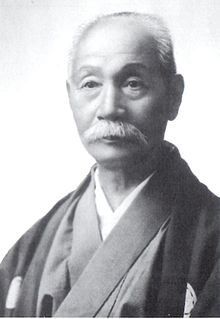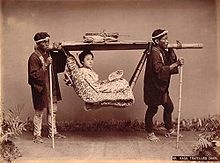Kusakabe Kimbei
Kusakabe Kimbei ( Japanese 日下 部 金幣 ) or Kusakabe Kimbē ( 日下部 金 兵衛 ) (* 1841 in Kōfu ; † 1932 in Ashiya ) was a Japanese photographer . He is considered one of the most important producers of souvenir photographs in Japan at the end of the 19th century.
Life

Kusakabe grew up in his native city of Kofu. His family was called Matsuya and they were in the cloth trade. At the age of fifteen or sixteen - the photo historian Terry Bennett means when he was eighteen - he went to Yokohama , which at that time was developing into a major port city with international tourism and the center of Japanese photography. In the 1860s and early 1870s he worked as a colorist and then became assistant to the photographer Felice Beato . This set stylistic standards in Yokohama's souvenir photography. Then Kusakabe may have assisted Raimund von Stillfried . From 1880 to 1914 he finally ran his own photo studio called K. Kimbei . Why he ran the studio under his first name is unknown, but modern photo historians suspect that he noticed when dealing with foreigners that they could pronounce and memorize his first name better than his last name. His range of souvenir photographs included not only his own works but also products by other photographers. Kusakabe as well as Stillfried and Adolfo Farsari kept pictures from the Beatos catalog despite the introduction of a Japanese copyright law (shashin jōrei) in 1876 . Both the resale of the pictures and their stylistic imitation can be interpreted as an homage or an intellectual challenge for the viewer and testify to their commercial success. Another explanation for the landscapes he did not take in his catalog could, according to Bennett, be that Kimbei first needed time to take his own pictures and the pictures of other photographers served him as a temporary solution in order to be able to offer the buyers a rich portfolio.
According to Terry Bennett, there is evidence that Kimbei did not own a studio from the start, but instead ran a photography shop. There is an advertisement published in the Japan Directory in 1883 , in which there was no reference to the photo studio opened in 1880 in No. 3 and K. Kimbei was now in No. 36 of the benten-dōri. From 1887 onwards, advertisements give addresses no. 36 and no. 27; in the latter, photographs only appeared to have been sold. Another shop was advertised in No. 4, where silk kakemono were available based on photographic motifs . From 1890 at the latest, his studio could be found in number 7 Honchō-dōri ( 本 町 通 ) in the immediate vicinity of the town hall.
While Kimbei was still able to claim in 1901 that his studio was the largest in Japan, sales of souvenir photographs declined drastically from 1907 at the latest. Thanks to technical innovations, such as Eastman-Kodak machines and films, it was now also possible for laypeople to take photographs of their trip. In addition to the emergence of postcards , this caused the market for the once very popular professional photographs to collapse. Kimbei now put the focus of his business on serving this lay clientele. In the meantime he had also opened a branch at No. 22, Ginza Sanchome in Tokyo.
In 1885 Kimbei adopted the Christian faith and was baptized in the kaigan church in Yokohama. He had at least two children, a son and a daughter. Due to disinterest on the part of the son, the son-in-law took over the business, but died before Kimbei. In his old age, Kimbei devoted himself mainly to painting and in 1930 moved to Ashiya to live with his granddaughter so that she could look after him.
plant

The assignment of photographs to Kusakabe, who called his studio K. Kimbei ( 金幣 写真 館 , Kimbei shashinkan , Eng . " Photo Studio Kimbei"), turns out to be difficult. This is partly because of the practice described above and partly because buyers of souvenir photographs often obtained them from different studios and then stuck them into an album. Since there was a turning point in Japanese photography around 1880 and more and more Japanese photographers were now active, there are also those of Ogawa Kazumasa ( 小川 一 眞 ; 1860–1929), Suzuki Shin'ichi ( 鈴木 真 一 ; 1835-1918) and Tamamura Kozaburō ( 玉 村 康三郎 ; 1856-1923?) In the albums.
Of the more than two thousand motifs offered in the catalog of the photo studio K. Kimbei, the vast majority showed views of popular travel destinations. 416 motifs from the catalog Photographic Studio K. Kimbei: No. 7 Honcho Dori, Yokohama. Colored Photographs, Views & Costumes of Japan. Beautfully Colored Transparencis, Magic Lantern Slides from 1893 show the customs of Japan. The absolute majority of these only portrayed women in various activities, which was common in souvenir photography.
However, the commercial popularity of portraits of women presented photographers with the problem that "decent" women mostly refused to be photographed. The two main reasons for this were, on the one hand, the realistic depiction, which was considered too sensual and made the woman's body available to the customer, which was rated as improper. On the other hand, there were various superstitious beliefs among Japanese contemporaries about the effects of being photographed. This sucks the sap of life from the sitter and weakens his shadow . For example, female family members or the kurōto, regarded as bijin (beautiful women) in the ukiyo-e tradition of the Meiji period , were often used as models by the photographers. These were women working in public such as yūjo ( courtesans ), geishas , rashamen ( prostitutes ), and girls who were employed in tea houses . Those women are already using their looks to better sell their services and topping up their salaries by working as photo models. Yūjos and geishas have already been photographed for their cartes de visite . There were also shops in the major cities called shashimpo specializing in geisha photography trade.
According to Wakita Mio, it is noticeable that only a few photographs of Kusakabe - five or two are named in the catalog - depict rashamen or courtesans. Instead, six of the more than ten employed studio models could be identified as famous geishas from Tokyo . Kusakabe staged his models as women of different social origins.
The use of geishas and the orientation towards the already established forms of expression of the bijinga (dt. Pictures of beautiful women) explains the strongly aesthetic representation of women in the various actions, in contrast to Felice Beato's pictures. Their actions were based on the kinkishoga ( 琴棋 書画 ), which originally represented an ideal for male writers. kin stood for music or the game of koto ; ki for the game of go , sho for calligraphy and ga for painting . Other occupations belonging to the stylization of geishas were positions in which they held a fan or read a book. According to Wakita, a photograph is an example of the fact that Kusakabe also took over the staging of eroticism from the bijinga , or more precisely from their variant of the abuna-e . In the picture with catalog number 16 with the title Wind Costume or Girl in Heavy Storm , the “wind”, ie thin wires, reveals the bottom layer of the kimono, which was later colored a strong red . In addition, the girl's feet in stockings are exposed.
Although geishas were known to keep up with the latest trends, they are portrayed very conservatively in Kusakabe's work. They do not wear the sokuhatsu hairstyle ( 束 髪 ), which was popular at the time and was inspired by Western fashions, but rather the traditional shimada hairstyle ( 島 田 ). And this at a time in which a fundamental change in the Japanese body image was taking place, which was initiated with the ban on both sexes of the nobility from coloring their teeth black and shaving their eyebrows. In addition, according to Wakita, it is remarkable that the pose of European romanticism , which was probably introduced into Japanese photography by Stillfried, is only used in one picture by Kusakabe: the hand position with folded fingers. Other Japanese photographers used her, such as Tamamura.
His photographs, which were made using the wet collodion process , were copied onto albumin paper and, if desired, colored by hand by employees. Many have an English-language title with catalog number imprinted on the negative. The formats offered by K. Kimbei ranged from carte de visite up to 32 by 24 inches. The former cost between two (1892) and two and a half (1894) dollars by the dozen uncoloured, the latter, which was assembled and of which, according to Bennett's research, no copy has come down to us, three dollars each.
4 Kago, Traveling Chair, Hakone Road - a tour group taking a break on the way to Hakone
literature
- Mio Wakita: Selling Japan. Kusakabe Kimbei's Image of Japanese Women . In: History of Photography . May 2009, ISSN 0308-7298 , p. 209-223 , doi : 10.1080 / 03087290902768149 .
- Mio Wakita: Staging Desires. Japanese feminity in Kusakabe Kimbei's Nineteenth-Century Souvenir Photography . Dietrich Reimer Verlag, Berlin 2013, ISBN 978-3-496-01467-6 . Also as a dissertation in 2010.
- Nakamura Hirotoshi ( 中 村 啓 信 ): 日下 部 金 兵衛 明治 時代 カ ラ ー 写真 の 巨人 (Kusakabe Kinbē: Meiji jidai karā shashin no kyojin). Kokusho Kankōkai, Tokyo 2006, ISBN 4-336-04772-3 .
- Klaus Lerch: The studio of Kusakabe Kimbei , Hibarios, Kaarst 2013, ISBN 978-3-945058-01-5 .
Web links
- Photographs in the Nagasaki University Library image database (Japanese)
- Kusakabe Kimbei's Photographs of Late 19th-Century Japan (English)
Individual evidence
- ^ Terry Bennett: Photography in Japan 1853-1912. Tokyo 2006, ISBN 0-8048-3633-7 , p. 205.
- ↑ Mio Wakita: Selling Japan. Kusakabe Kimbei's Image of Japanese Women. In: History of Photography. May 2009, ISSN 0308-7298 , pp. 209-223, p. 211.
- ^ Terry Bennett: Photography in Japan 1853-1912. Tokyo 2006, ISBN 0-8048-3633-7 , p. 205.
- ↑ Mio Wakita: Selling Japan. Kusakabe Kimbei's Image of Japanese Women. In: History of Photography. May 2009, ISSN 0308-7298 , pp. 209-223, p. 211.
- ^ Terry Bennett: Photography in Japan 1853-1912. Tokyo 2006, ISBN 0-8048-3633-7 , p. 205.
- ^ Terry Bennett: Photography in Japan 1853-1912. Tokyo 2006, ISBN 0-8048-3633-7 , p. 204.
- ^ Terry Bennett: Photography in Japan 1853-1912. Tokyo 2006, ISBN 0-8048-3633-7 , p. 206.
- ↑ Mio Wakita: Selling Japan. Kusakabe Kimbei's Image of Japanese Women. In: History of Photography. May 2009, ISSN 0308-7298 , pp. 209-223, pp. 218 f.
- ↑ Mio Wakita: Selling Japan. Kusakabe Kimbei's Image of Japanese Women. In: History of Photography. May 2009, ISSN 0308-7298 , pp. 209-223, p. 221.
- ↑ Mio Wakita: Selling Japan. Kusakabe Kimbei's Image of Japanese Women. In: History of Photography. May 2009, ISSN 0308-7298 , pp. 209-223, p. 214.
- ↑ A woman with a sokuhatsu hairstyle from a Japan Magazine from 1913. ( Memento from March 19, 2013 in the Internet Archive )
- ↑ A woman with a shimada hairstyle from a Japan Magazine from 1913. ( Memento from March 19, 2013 in the Internet Archive )
- ↑ Mio Wakita: Selling Japan. Kusakabe Kimbei's Image of Japanese Women. In: History of Photography. May 2009, ISSN 0308-7298 , pp. 209-223, p. 217.
- ^ Terry Bennett: Photography in Japan 1853-1912. Tokyo 2006, ISBN 0-8048-3633-7 , pp. 204 f.
| personal data | |
|---|---|
| SURNAME | Kusakabe, Kimbei |
| ALTERNATIVE NAMES | 日下 部 金 兵衛 (Japanese); 日下 部 金幣 (Japanese); Kusakabe, Kimbē; Kusakabe, Kinbei |
| BRIEF DESCRIPTION | Japanese photographer |
| DATE OF BIRTH | 1841 |
| PLACE OF BIRTH | Kofu |
| DATE OF DEATH | 1932 |
| Place of death | Ashiya |










